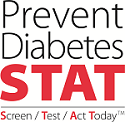Resources for Screening & Referral

The American Medical Association (AMA) and CDC teamed up to provide a suite of tools to help you with screening for prediabetes and referring patients to a CDC-recognized diabetes prevention lifestyle change program.
These tools are part of the Prevent Diabetes STAT – Screen, Test, Act Today™ initiative, designed to raise diabetes awareness and increase participation in lifestyle change programs. They also are available in the Preventing Type 2 Diabetes downloadable toolkit [PDF - 1MB] .
Resources for Screening, Testing, and Referral
These tools can help you incorporate into your practice screening and testing for prediabetes and referral of patients with prediabetes to CDC-recognized diabetes prevention lifestyle change programs.
M.A.P. to Diabetes Prevention for Your Practice [PDF - 315KB]
Use this document to help determine roles and responsibilities for identifying adult patients with prediabetes and referring to community-based diabetes prevention programs.
Patient Flow Process [PDF - 328KB]
This infographic provides a high-level overview of how office staff can facilitate point-of-care identification of patients with prediabetes.
Point-of-Care Prediabetes Identification Algorithm [PDF - 401KB]
Use this infographic to adapt/incorporate a prediabetes identification and referral process into your workflow.
Retrospective Prediabetes Identification Algorithm [PDF - 343KB]
Use this infographic to adapt/incorporate an identification and referral process into your electronic health records and generate a registry of patients at risk for type 2 diabetes.
Sample Patient Referral Form/Table for Calculating Body Mass Index [PDF - 386KB]
This form makes the referral process easier, helps engage patients, and prepares lifestyle change program providers to engage with patients as well.
Commonly Used Current Procedural Terminology and ICD Codes [PDF - 385KB]
Enables physician practices to obtain reimbursement for prediabetes screening.
These tools are part of the Preventing Type 2 Diabetes Toolkit. Download the entire toolkit [PDF - 1.29MB].
Materials to Engage Patients
Use these tools to help educate patients about prediabetes and its link to type 2 diabetes and what to do if they are at risk.
Prediabetes Risk Assessment [PDF - 862KB]
This questionnaire helps patients learn about their risk for prediabetes and helps care teams identify patients at high risk.
Promoting Prediabetes Awareness to Your Patients [PDF - 279KB]
Use this poster to increase patient awareness of prediabetes and start conversations about screening, testing, and referral.
Are You at Risk for Type 2 Diabetes? [PDF - 96KB]
Place this patient handout in waiting areas to increase awareness and start conversations about screening, testing, and referral.
So You Have Diabetes... Now What? [PDF - 409KB]
Use this patient handout in the exam room after screening has revealed that a patient has prediabetes. This provides the patient with concrete information for later reference.
Sample Patient Letter/Email and Phone Script [PDF - 134KB]
This letter/email template may help your practice conduct efficient follow-up and referral with at-risk patients who are eligible for the lifestyle change program.
These tools are part of the Preventing Type 2 Diabetes Toolkit. Download the entire toolkit [PDF - 1.29MB].
Materials to Share With Your Colleagues and Health Care Team
Share these materials with members of your health care team, to educate them about CDC-recognized diabetes prevention lifestyle change programs and their benefits.
You Can Prevent Type 2 Diabetes [PDF-148KB]
This fact sheet provides a brief overview of the evidence-based diabetes prevention program and a rationale for engaging with the program.
The Evidence Behind the Diabetes Prevention Program [PDF-306KB]
This fact sheet summarizes studies conducted over the last 15 years, documenting the evidence base for the prevention of diabetes through lifestyle change programs.
These tools are part of the Preventing Type 2 Diabetes Toolkit. Download the entire toolkit [PDF - 1.29MB].
- Page last reviewed: July 7, 2016
- Page last updated: July 7, 2016
- Content source:
- Maintained By:


 ShareCompartir
ShareCompartir